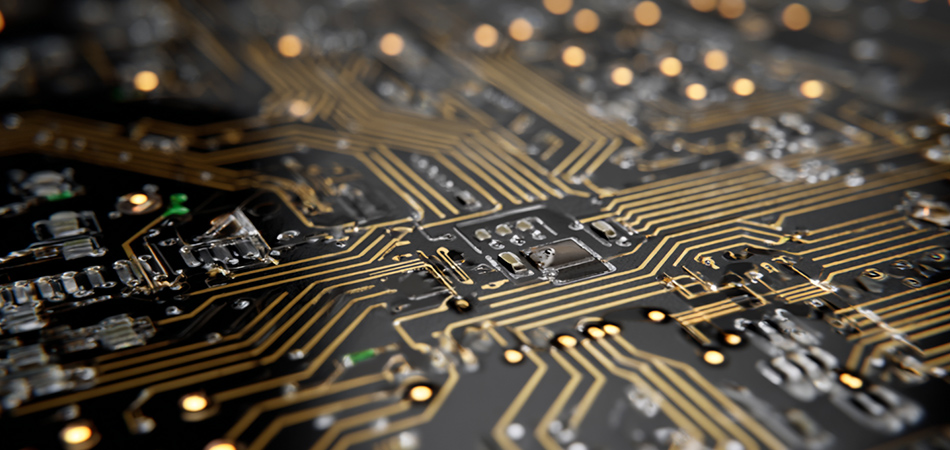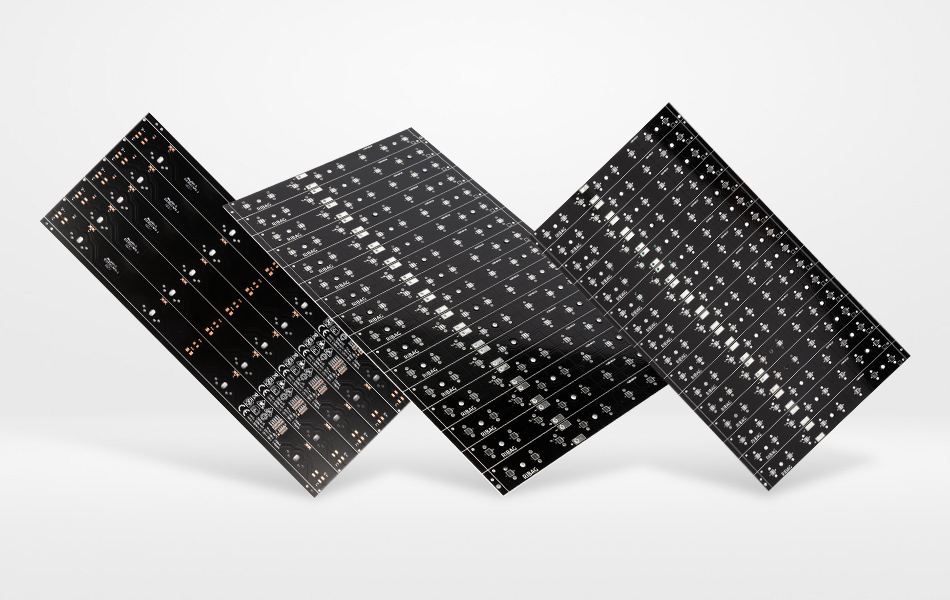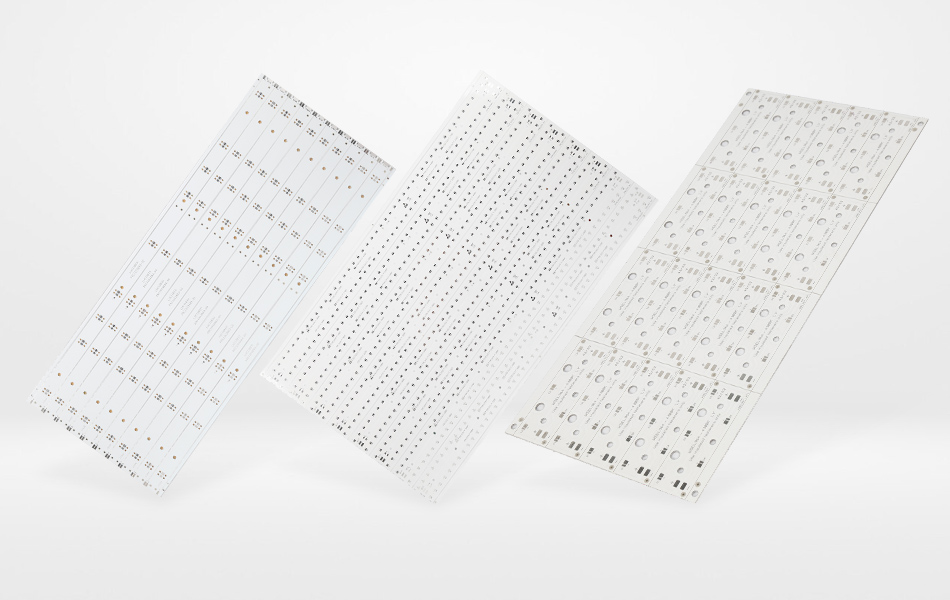-
- PCB TYPE
- PRINTED CIRCUIT BOARD PROTOTYPE ALUMINUM PRINTED CIRCUIT BOARD R&F PCB FPC HIGH FREQUENCY PCB HIGH-TG PCB HEAVY COPPER PCB HDI PCB PCB FOR LIGHTING METAL CORE PCB
time:Jun 28. 2025, 09:41:30
In the evolving landscape of electronics manufacturing, the demand for environmentally responsible solutions has spurred the development of halogen-free aluminum metal PCBs. These boards combine the thermal and mechanical advantages of aluminum PCBs with the eco-friendly benefits of halogen-free materials, addressing both performance requirements and sustainability goals. This article explores the technical foundations, manufacturing processes, environmental benefits, and industry applications of halogen-free aluminum metal PCBs, highlighting their role in shaping the future of green electronics.
Technical Foundations of Halogen-Free Aluminum PCBs
Definition and Core Features
Halogen-free aluminum metal PCBs are defined by their absence of halogen elements—such as chlorine (Cl) and bromine (Br)—in key components like the dielectric layer, solder masks, and surface finishes. This distinguishes them from traditional PCBs, which often use halogenated flame retardants (HFRs) like brominated epoxy resins. The integration of aluminum as the base material retains their thermal conductivity and mechanical strength, while halogen-free formulations enhance environmental compatibility.
Key features include:
Flame Retardancy Without Halogens: Achieved through alternative flame-retardant additives like metal hydroxides, phosphorus-based compounds, or silicon-based materials.
Thermal Stability: Maintained via advanced halogen-free dielectric materials that withstand high operating temperatures.
Electrical Performance: Comparable to traditional aluminum PCBs, with optimized insulation resistance and dielectric breakdown voltage.
Material Composition Differences
Dielectric Layer Innovations
Halogen-free dielectric materials for aluminum PCBs often incorporate:
Ceramic-Filled Polymers: Improve thermal conductivity while maintaining electrical insulation.
Phosphorus-Contained Resins: Provide flame retardancy without halogen elements.
Silicone-Based Compounds: Offer flexibility and high-temperature resistance for dynamic applications.
These materials must balance three critical properties: thermal conductivity (≥1.0 W/m·K), dielectric constant (≤4.0 at 1 MHz), and volume resistivity (≥10^12 Ω·cm) to ensure optimal performance.
Solder Masks and Surface Finishes
Halogen-free solder masks use acrylic or epoxy formulations with inorganic flame retardants. Common surface finishes include:
Electroless Nickel Immersion Gold (ENIG): Halogen-free ENIG processes avoid bromide in plating baths.
Organic Solderability Preservatives (OSP): Water-based OSP solutions replace halogenated solvents.
Tin Plating: Lead-free tin alloys compliant with RoHS regulations.
Environmental Advantages
Reduced Toxic Emissions
Halogen-free PCBs eliminate the release of toxic halogenated gases—such as dioxins and furans—during manufacturing, soldering, or thermal stress. This aligns with regulations like the Restriction of Hazardous Substances (RoHS) and Waste Electrical and Electronic Equipment (WEEE) directives.
Improved Recyclability
Halogen-free materials facilitate easier recycling, as halogenated compounds can contaminate recycling streams. Aluminum substrates, already highly recyclable, combined with halogen-free dielectrics, enable more sustainable end-of-life management.

Manufacturing Processes for Halogen-Free Aluminum PCBs
Material Preparation
Aluminum Substrate Selection
High-purity aluminum alloys (e.g., 1050 or 3003 series) are chosen for their thermal conductivity and formability. Surface pretreatment may include:
Anodizing: Creates a protective oxide layer without halogen-based chemicals.
Chromate-Free Conversion Coatings: Enhance adhesion of dielectric layers using zirconium or titanium compounds.
Halogen-Free Dielectric Lamination
Dielectric layers are laminated using:
Hot Press Lamination: Applies heat (150–200°C) and pressure (5–10 MPa) to cure halogen-free prepregs.
Vacuum Lamination: Minimizes voids in multi-layer boards, critical for thermal performance.
Specialized curing cycles avoid thermal degradation of halogen-free resins, which may have different activation temperatures than halogenated counterparts.
Circuit Patterning and Drilling
Photolithography and Etching
Halogen-free photoresists use chemical amplification technology to achieve fine-line patterning (≤50 μm). Etching solutions are optimized for copper removal without halogenated additives, often using ammonium persulfate or ferric chloride.
Precision Drilling
CNC drilling of vias and mounting holes requires:
Diamond-Coated Drill Bits: For aluminum substrates to reduce burr formation.
Coolant Systems: Using water-based fluids instead of halogenated solvents to maintain hole quality.
Surface Finishing and Quality Control
Halogen-Free Solder Mask Application
Solder masks are applied via:
Screen Printing: For thick films (20–50 μm) on high-power areas.
Spray Coating: For uniform thin films (5–15 μm) in precision applications.
Curing processes use UV or thermal methods, ensuring complete cross-linking of halogen-free resins.
Environmental Testing
Key tests for halogen-free PCBs include:
Flame Retardancy Testing: According to UL94 V-0 standards using non-halogenated flame sources.
Thermal Shock Testing: To verify stability at -40°C to +125°C cycles.
Halogen Content Analysis: Using ion chromatography to confirm Cl and Br content <900 ppm each.

Performance Considerations
Thermal Management
Halogen-free dielectric materials may have slightly lower thermal conductivity than halogenated ones, but advancements in filler technology have narrowed this gap. Thermal vias and copper pour designs can further enhance heat dissipation, maintaining equivalent performance to traditional aluminum PCBs in most applications.
Electrical Insulation
While halogen-free dielectrics offer comparable volume resistivity, their dielectric loss tangent (tanδ) may be slightly higher at high frequencies. This requires careful design in RF applications, but for most power and digital circuits, the difference is negligible.
Mechanical Durability
Aluminum substrates provide consistent mechanical strength, but halogen-free dielectrics may have different flexural modulus and impact resistance. Manufacturers often optimize laminate thickness ratios (copper/dielectric/aluminum) to balance flexibility and rigidity for specific applications.

Industry Applications of Halogen-Free Aluminum PCBs
Consumer Electronics
Sustainable Mobile Devices
Halogen-free aluminum PCBs are used in high-end smartphones and laptops for:
Eco-Friendly Design: Meeting consumer demand for sustainable electronics.
Thermal Management: Cooling powerful APUs and 5G modems without halogenated materials.
Thin Profiles: Enabling slim device designs with integrated heat dissipation.
Home Appliances
In smart home devices and energy-efficient appliances, these PCBs:
Reduce Environmental Impact: During manufacturing and disposal.
Withstand High Temperatures: In kitchen appliances like induction cooktops.
Enable Compact Designs: For IoT - enabled thermostats and security systems.
Lighting Industry
Green LED Lighting
Halogen-free aluminum PCBs are ideal for:
Outdoor Lighting: Withstanding UV exposure and harsh weather without halogen degradation.
Indoor Commercial Lighting: Meeting LEED certification requirements for low - VOC materials.
Automotive Lighting: Complying with automotive industry regulations on hazardous substances.
Medical Devices
Healthcare Equipment
In medical electronics, they offer:
Biocompatibility: Reduced risk of halogen - related toxic emissions in hospital environments.
Sterilization Resistance: Withstanding autoclaving and chemical disinfection.
Reliability: Critical for life - support systems and diagnostic equipment.
Industrial and Aerospace
Industrial Automation
Halogen-free aluminum PCBs are used in:
Robotics: Withstanding mechanical stress and thermal cycles.
Renewable Energy Systems: Solar inverters and wind turbine controllers requiring eco - friendly components.
Hazardous Environments: Mining and oil & gas equipment, where halogen - free materials reduce fire risks.
Aerospace and Defense
In avionics, these PCBs:
Meet Stringent Environmental Standards: For low - outgassing in satellite applications.
Ensure Reliability: In extreme temperatures and radiation - intensive environments.
Support Sustainable Aviation: Aligning with aerospace industry goals for greener electronics.

Regulatory and Standards Landscape
Global Environmental Regulations
RoHS 3: Restricts ten hazardous substances, including halogenated flame retardants.
REACH: Requires registration of chemicals, including halogenated compounds.
IPC-4101F: Specifies requirements for halogen-free base materials, defining Cl/Br limits.
Industry - Specific Standards
UL94 V - 0: Updated to recognize halogen-free flame - retardant mechanisms.
JEDEC J - STD - 020: Moisture and reliability testing for halogen-free PCBs in automotive applications.
IPC - J - STD - 001: Soldering requirements for halogen-free surface finishes.

Future Trends in Halogen - Free Aluminum PCB Technology
Advanced Material Innovations
Nano - Composite Dielectrics: Combining nanoceramics with halogen-free resins to improve thermal conductivity.
Biobased Polymers: Developing plant - derived materials for dielectric layers.
Graphene - Enhanced Materials: Using graphene fillers to boost thermal and electrical performance.
Manufacturing Process Optimization
Additive Manufacturing: 3D printing of halogen-free aluminum PCBs for rapid prototyping.
Laser Direct Imaging (LDI): Enabling finer traces and higher density in halogen-free boards.
Automated Optical Inspection (AOI): With AI algorithms to detect halogen - related defects.
Circular Economy Initiatives
Closed - Loop Recycling: Systems for recovering aluminum and copper from halogen-free PCBs.
Design for Disassembly (DfD): Modular PCB designs to facilitate material separation.
Second - Life Applications: Repurposing halogen-free PCBs in lower - power devices.
Integration with Emerging Technologies
5G and IoT: High - frequency, low - loss halogen-free PCBs for next - generation connectivity.
Wearables: Flexible halogen-free aluminum PCBs for health - monitoring devices.
Electric Vehicles (EVs): High - power, high - reliability PCBs for EV drivetrains and charging systems.
Challenges and Mitigation Strategies
Material Cost and Availability
Halogen-free materials can be 10–20% more expensive than halogenated alternatives. However, economies of scale and increased demand are reducing costs. Manufacturers are also exploring regional supply chains to ensure material availability.
Process Compatibility
Retrofitting production lines for halogen-free processes requires investment in new equipment and training. Industry collaborations and standardization efforts are helping to streamline this transition.
Performance Trade - offs
Balancing flame retardancy, thermal conductivity, and electrical insulation in halogen-free materials remains a challenge. Ongoing R&D in additive chemistry is addressing these trade-offs, with new formulations approaching the performance of halogenated materials.
Conclusion
Halogen-free aluminum metal PCBs represent a significant advancement in sustainable electronics manufacturing, combining the high performance of aluminum PCBs with environmental responsibility. As global regulations tighten and consumer demand for green technology grows, these boards are set to become the standard in industries ranging from consumer electronics to aerospace. By addressing challenges in material science, manufacturing, and recycling, halogen-free aluminum PCBs are not only meeting current sustainability goals but also paving the way for the next generation of eco-friendly electronic devices. Their ability to balance performance, reliability, and environmental stewardship makes them a cornerstone of the circular economy in electronics.

Got project ready to assembly? Contact us: info@apollopcb.com



We're not around but we still want to hear from you! Leave us a note:

Leave Message to APOLLOPCB
